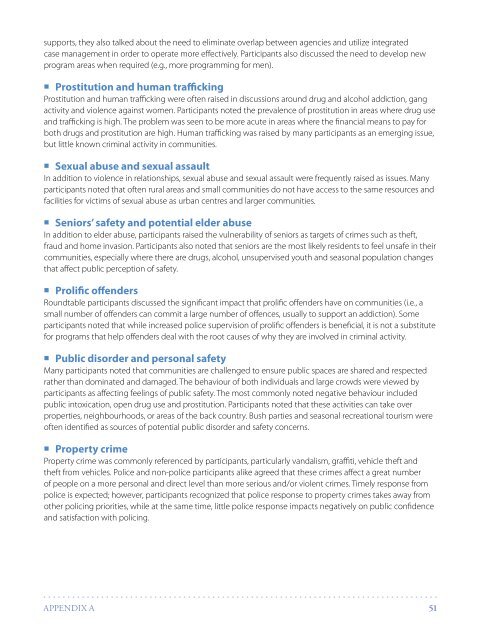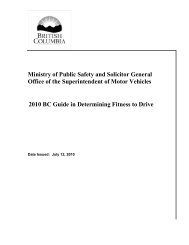BC Policing and Community Safety Plan - Ministry of Justice ...
BC Policing and Community Safety Plan - Ministry of Justice ...
BC Policing and Community Safety Plan - Ministry of Justice ...
You also want an ePaper? Increase the reach of your titles
YUMPU automatically turns print PDFs into web optimized ePapers that Google loves.
supports, they also talked about the need to eliminate overlap between agencies <strong>and</strong> utilize integratedcase management in order to operate more effectively. Participants also discussed the need to develop newprogram areas when required (e.g., more programming for men).•¡Prostitution <strong>and</strong> human traffickingProstitution <strong>and</strong> human trafficking were <strong>of</strong>ten raised in discussions around drug <strong>and</strong> alcohol addiction, gangactivity <strong>and</strong> violence against women. Participants noted the prevalence <strong>of</strong> prostitution in areas where drug use<strong>and</strong> trafficking is high. The problem was seen to be more acute in areas where the financial means to pay forboth drugs <strong>and</strong> prostitution are high. Human trafficking was raised by many participants as an emerging issue,but little known criminal activity in communities.•¡Sexual abuse <strong>and</strong> sexual assaultIn addition to violence in relationships, sexual abuse <strong>and</strong> sexual assault were frequently raised as issues. Manyparticipants noted that <strong>of</strong>ten rural areas <strong>and</strong> small communities do not have access to the same resources <strong>and</strong>facilities for victims <strong>of</strong> sexual abuse as urban centres <strong>and</strong> larger communities.•¡Seniors’ safety <strong>and</strong> potential elder abuseIn addition to elder abuse, participants raised the vulnerability <strong>of</strong> seniors as targets <strong>of</strong> crimes such as theft,fraud <strong>and</strong> home invasion. Participants also noted that seniors are the most likely residents to feel unsafe in theircommunities, especially where there are drugs, alcohol, unsupervised youth <strong>and</strong> seasonal population changesthat affect public perception <strong>of</strong> safety.•¡Prolific <strong>of</strong>fendersRoundtable participants discussed the significant impact that prolific <strong>of</strong>fenders have on communities (i.e., asmall number <strong>of</strong> <strong>of</strong>fenders can commit a large number <strong>of</strong> <strong>of</strong>fences, usually to support an addiction). Someparticipants noted that while increased police supervision <strong>of</strong> prolific <strong>of</strong>fenders is beneficial, it is not a substitutefor programs that help <strong>of</strong>fenders deal with the root causes <strong>of</strong> why they are involved in criminal activity.•¡Public disorder <strong>and</strong> personal safetyMany participants noted that communities are challenged to ensure public spaces are shared <strong>and</strong> respectedrather than dominated <strong>and</strong> damaged. The behaviour <strong>of</strong> both individuals <strong>and</strong> large crowds were viewed byparticipants as affecting feelings <strong>of</strong> public safety. The most commonly noted negative behaviour includedpublic intoxication, open drug use <strong>and</strong> prostitution. Participants noted that these activities can take overproperties, neighbourhoods, or areas <strong>of</strong> the back country. Bush parties <strong>and</strong> seasonal recreational tourism were<strong>of</strong>ten identified as sources <strong>of</strong> potential public disorder <strong>and</strong> safety concerns.¡ • Property crimeProperty crime was commonly referenced by participants, particularly v<strong>and</strong>alism, graffiti, vehicle theft <strong>and</strong>theft from vehicles. Police <strong>and</strong> non-police participants alike agreed that these crimes affect a great number<strong>of</strong> people on a more personal <strong>and</strong> direct level than more serious <strong>and</strong>/or violent crimes. Timely response frompolice is expected; however, participants recognized that police response to property crimes takes away fromother policing priorities, while at the same time, little police response impacts negatively on public confidence<strong>and</strong> satisfaction with policing.APPENDIX A 51
















